Analysis of Business Types, Structures, and External Impacts
VerifiedAdded on 2022/11/30
|10
|2447
|414
Report
AI Summary
This report provides a comprehensive analysis of different business types, including micro, medium, and large businesses, examining their characteristics and examples. It delves into various company structures, such as sole traders, partnerships, limited liability businesses, and cooperatives, highlighting their operational aspects. Furthermore, the report explores different organizational structures, including hierarchical, functional, and horizontal structures, discussing their advantages and disadvantages. It also analyzes how external factors, such as political, economic, social, technological, environmental, and legal factors (PESTEL analysis), impact business operations. The report concludes by emphasizing the importance of understanding these elements for effective decision-making and achieving business goals.

3002
Paraphrase This Document
Need a fresh take? Get an instant paraphrase of this document with our AI Paraphraser

Table of Contents
INTRODUCTION......................................................................................................................3
MAIN BODY.............................................................................................................................3
Section 1.....................................................................................................................................3
Explain characteristics, examples, of micro businesses, medium size business and large
size business...........................................................................................................................3
Section 2.....................................................................................................................................4
Analyse various companies in business.................................................................................4
Section 3.....................................................................................................................................5
Examine about different types of organisational structures & how external factors affect
business..................................................................................................................................5
CONCLUSION..........................................................................................................................8
REFERENCES...........................................................................................................................9
Books & Journal:....................................................................................................................9
INTRODUCTION......................................................................................................................3
MAIN BODY.............................................................................................................................3
Section 1.....................................................................................................................................3
Explain characteristics, examples, of micro businesses, medium size business and large
size business...........................................................................................................................3
Section 2.....................................................................................................................................4
Analyse various companies in business.................................................................................4
Section 3.....................................................................................................................................5
Examine about different types of organisational structures & how external factors affect
business..................................................................................................................................5
CONCLUSION..........................................................................................................................8
REFERENCES...........................................................................................................................9
Books & Journal:....................................................................................................................9
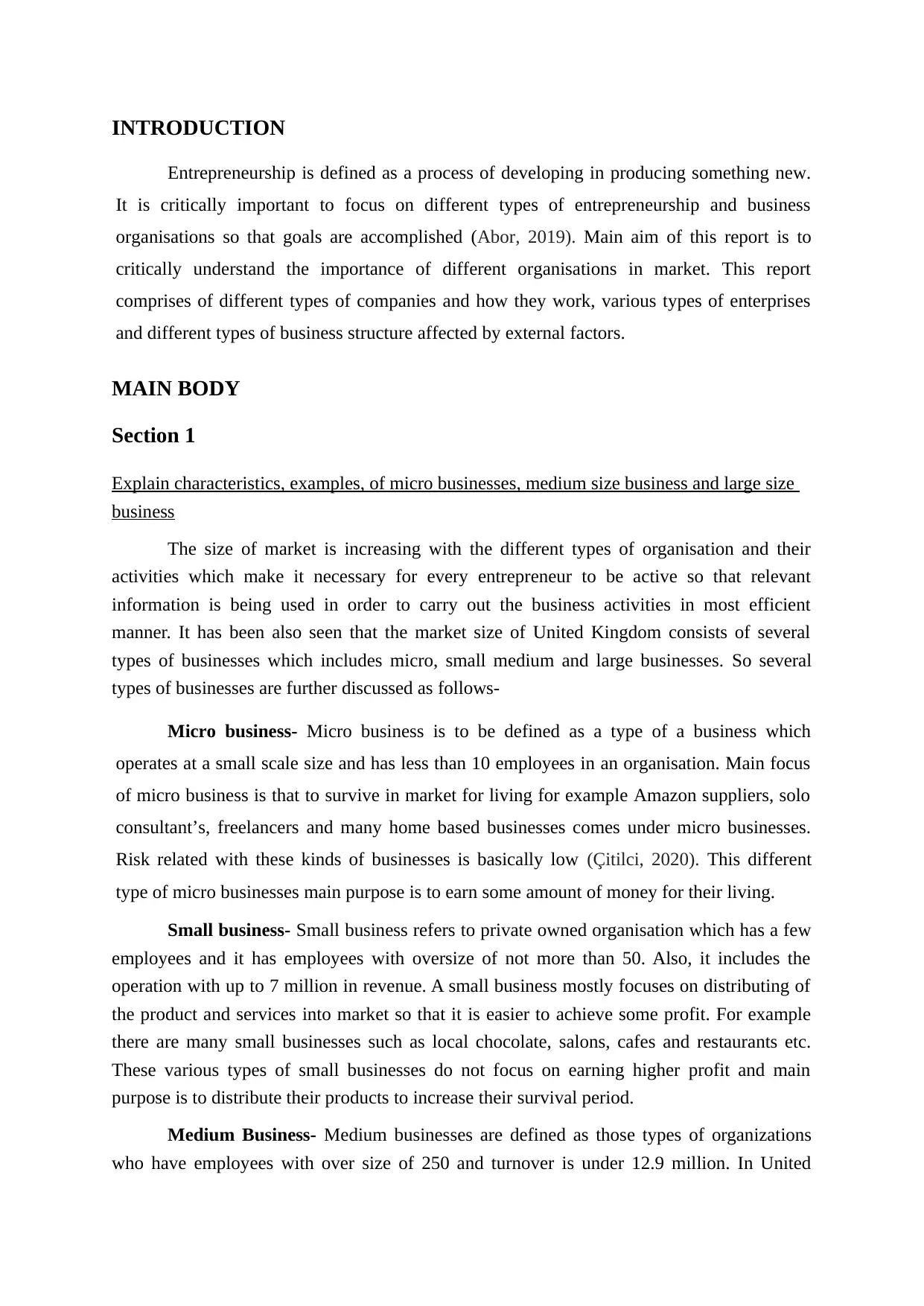
INTRODUCTION
Entrepreneurship is defined as a process of developing in producing something new.
It is critically important to focus on different types of entrepreneurship and business
organisations so that goals are accomplished (Abor, 2019). Main aim of this report is to
critically understand the importance of different organisations in market. This report
comprises of different types of companies and how they work, various types of enterprises
and different types of business structure affected by external factors.
MAIN BODY
Section 1
Explain characteristics, examples, of micro businesses, medium size business and large size
business
The size of market is increasing with the different types of organisation and their
activities which make it necessary for every entrepreneur to be active so that relevant
information is being used in order to carry out the business activities in most efficient
manner. It has been also seen that the market size of United Kingdom consists of several
types of businesses which includes micro, small medium and large businesses. So several
types of businesses are further discussed as follows-
Micro business- Micro business is to be defined as a type of a business which
operates at a small scale size and has less than 10 employees in an organisation. Main focus
of micro business is that to survive in market for living for example Amazon suppliers, solo
consultant’s, freelancers and many home based businesses comes under micro businesses.
Risk related with these kinds of businesses is basically low (Çitilci, 2020). This different
type of micro businesses main purpose is to earn some amount of money for their living.
Small business- Small business refers to private owned organisation which has a few
employees and it has employees with oversize of not more than 50. Also, it includes the
operation with up to 7 million in revenue. A small business mostly focuses on distributing of
the product and services into market so that it is easier to achieve some profit. For example
there are many small businesses such as local chocolate, salons, cafes and restaurants etc.
These various types of small businesses do not focus on earning higher profit and main
purpose is to distribute their products to increase their survival period.
Medium Business- Medium businesses are defined as those types of organizations
who have employees with over size of 250 and turnover is under 12.9 million. In United
Entrepreneurship is defined as a process of developing in producing something new.
It is critically important to focus on different types of entrepreneurship and business
organisations so that goals are accomplished (Abor, 2019). Main aim of this report is to
critically understand the importance of different organisations in market. This report
comprises of different types of companies and how they work, various types of enterprises
and different types of business structure affected by external factors.
MAIN BODY
Section 1
Explain characteristics, examples, of micro businesses, medium size business and large size
business
The size of market is increasing with the different types of organisation and their
activities which make it necessary for every entrepreneur to be active so that relevant
information is being used in order to carry out the business activities in most efficient
manner. It has been also seen that the market size of United Kingdom consists of several
types of businesses which includes micro, small medium and large businesses. So several
types of businesses are further discussed as follows-
Micro business- Micro business is to be defined as a type of a business which
operates at a small scale size and has less than 10 employees in an organisation. Main focus
of micro business is that to survive in market for living for example Amazon suppliers, solo
consultant’s, freelancers and many home based businesses comes under micro businesses.
Risk related with these kinds of businesses is basically low (Çitilci, 2020). This different
type of micro businesses main purpose is to earn some amount of money for their living.
Small business- Small business refers to private owned organisation which has a few
employees and it has employees with oversize of not more than 50. Also, it includes the
operation with up to 7 million in revenue. A small business mostly focuses on distributing of
the product and services into market so that it is easier to achieve some profit. For example
there are many small businesses such as local chocolate, salons, cafes and restaurants etc.
These various types of small businesses do not focus on earning higher profit and main
purpose is to distribute their products to increase their survival period.
Medium Business- Medium businesses are defined as those types of organizations
who have employees with over size of 250 and turnover is under 12.9 million. In United
⊘ This is a preview!⊘
Do you want full access?
Subscribe today to unlock all pages.

Trusted by 1+ million students worldwide
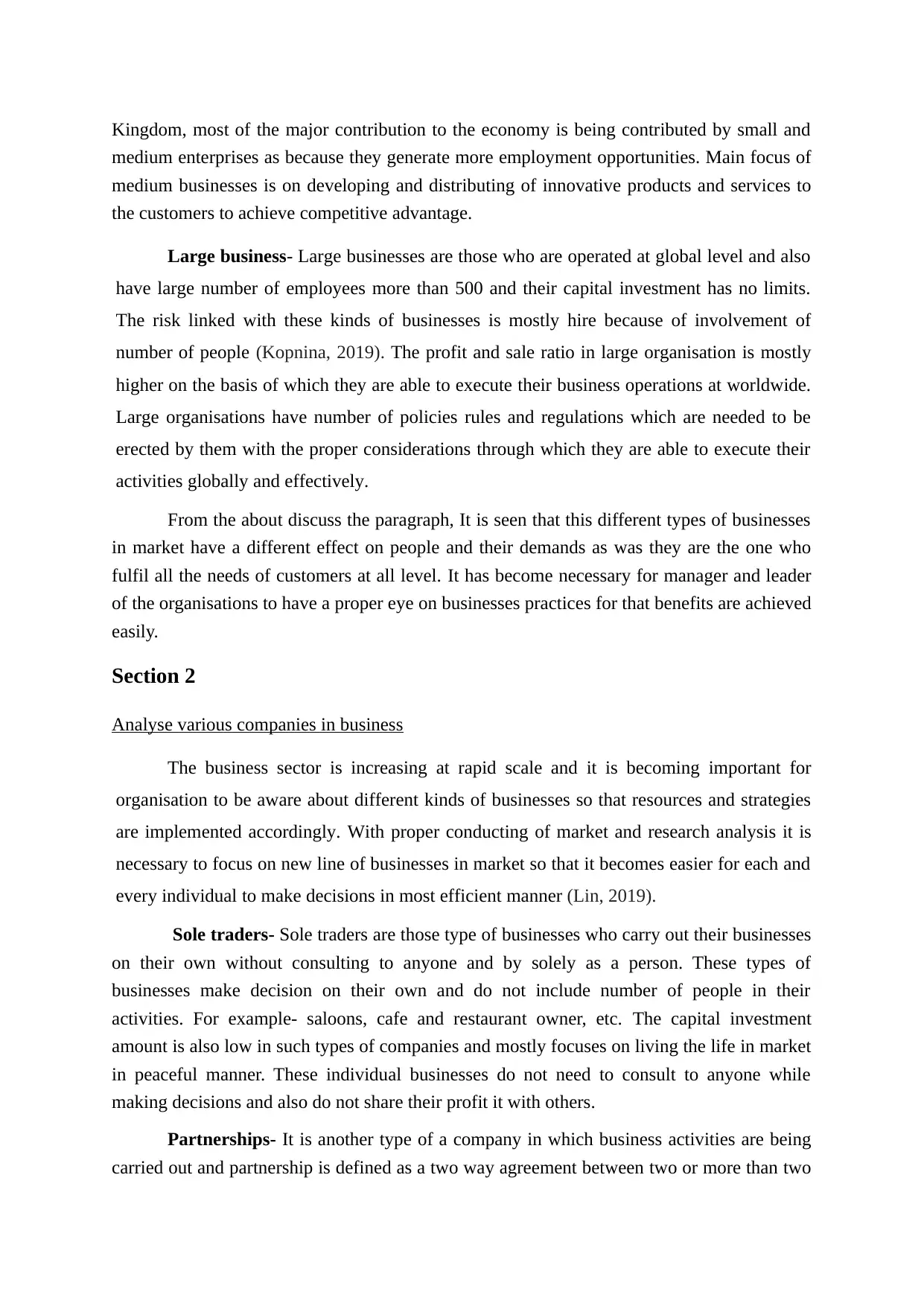
Kingdom, most of the major contribution to the economy is being contributed by small and
medium enterprises as because they generate more employment opportunities. Main focus of
medium businesses is on developing and distributing of innovative products and services to
the customers to achieve competitive advantage.
Large business- Large businesses are those who are operated at global level and also
have large number of employees more than 500 and their capital investment has no limits.
The risk linked with these kinds of businesses is mostly hire because of involvement of
number of people (Kopnina, 2019). The profit and sale ratio in large organisation is mostly
higher on the basis of which they are able to execute their business operations at worldwide.
Large organisations have number of policies rules and regulations which are needed to be
erected by them with the proper considerations through which they are able to execute their
activities globally and effectively.
From the about discuss the paragraph, It is seen that this different types of businesses
in market have a different effect on people and their demands as was they are the one who
fulfil all the needs of customers at all level. It has become necessary for manager and leader
of the organisations to have a proper eye on businesses practices for that benefits are achieved
easily.
Section 2
Analyse various companies in business
The business sector is increasing at rapid scale and it is becoming important for
organisation to be aware about different kinds of businesses so that resources and strategies
are implemented accordingly. With proper conducting of market and research analysis it is
necessary to focus on new line of businesses in market so that it becomes easier for each and
every individual to make decisions in most efficient manner (Lin, 2019).
Sole traders- Sole traders are those type of businesses who carry out their businesses
on their own without consulting to anyone and by solely as a person. These types of
businesses make decision on their own and do not include number of people in their
activities. For example- saloons, cafe and restaurant owner, etc. The capital investment
amount is also low in such types of companies and mostly focuses on living the life in market
in peaceful manner. These individual businesses do not need to consult to anyone while
making decisions and also do not share their profit it with others.
Partnerships- It is another type of a company in which business activities are being
carried out and partnership is defined as a two way agreement between two or more than two
medium enterprises as because they generate more employment opportunities. Main focus of
medium businesses is on developing and distributing of innovative products and services to
the customers to achieve competitive advantage.
Large business- Large businesses are those who are operated at global level and also
have large number of employees more than 500 and their capital investment has no limits.
The risk linked with these kinds of businesses is mostly hire because of involvement of
number of people (Kopnina, 2019). The profit and sale ratio in large organisation is mostly
higher on the basis of which they are able to execute their business operations at worldwide.
Large organisations have number of policies rules and regulations which are needed to be
erected by them with the proper considerations through which they are able to execute their
activities globally and effectively.
From the about discuss the paragraph, It is seen that this different types of businesses
in market have a different effect on people and their demands as was they are the one who
fulfil all the needs of customers at all level. It has become necessary for manager and leader
of the organisations to have a proper eye on businesses practices for that benefits are achieved
easily.
Section 2
Analyse various companies in business
The business sector is increasing at rapid scale and it is becoming important for
organisation to be aware about different kinds of businesses so that resources and strategies
are implemented accordingly. With proper conducting of market and research analysis it is
necessary to focus on new line of businesses in market so that it becomes easier for each and
every individual to make decisions in most efficient manner (Lin, 2019).
Sole traders- Sole traders are those type of businesses who carry out their businesses
on their own without consulting to anyone and by solely as a person. These types of
businesses make decision on their own and do not include number of people in their
activities. For example- saloons, cafe and restaurant owner, etc. The capital investment
amount is also low in such types of companies and mostly focuses on living the life in market
in peaceful manner. These individual businesses do not need to consult to anyone while
making decisions and also do not share their profit it with others.
Partnerships- It is another type of a company in which business activities are being
carried out and partnership is defined as a two way agreement between two or more than two
Paraphrase This Document
Need a fresh take? Get an instant paraphrase of this document with our AI Paraphraser
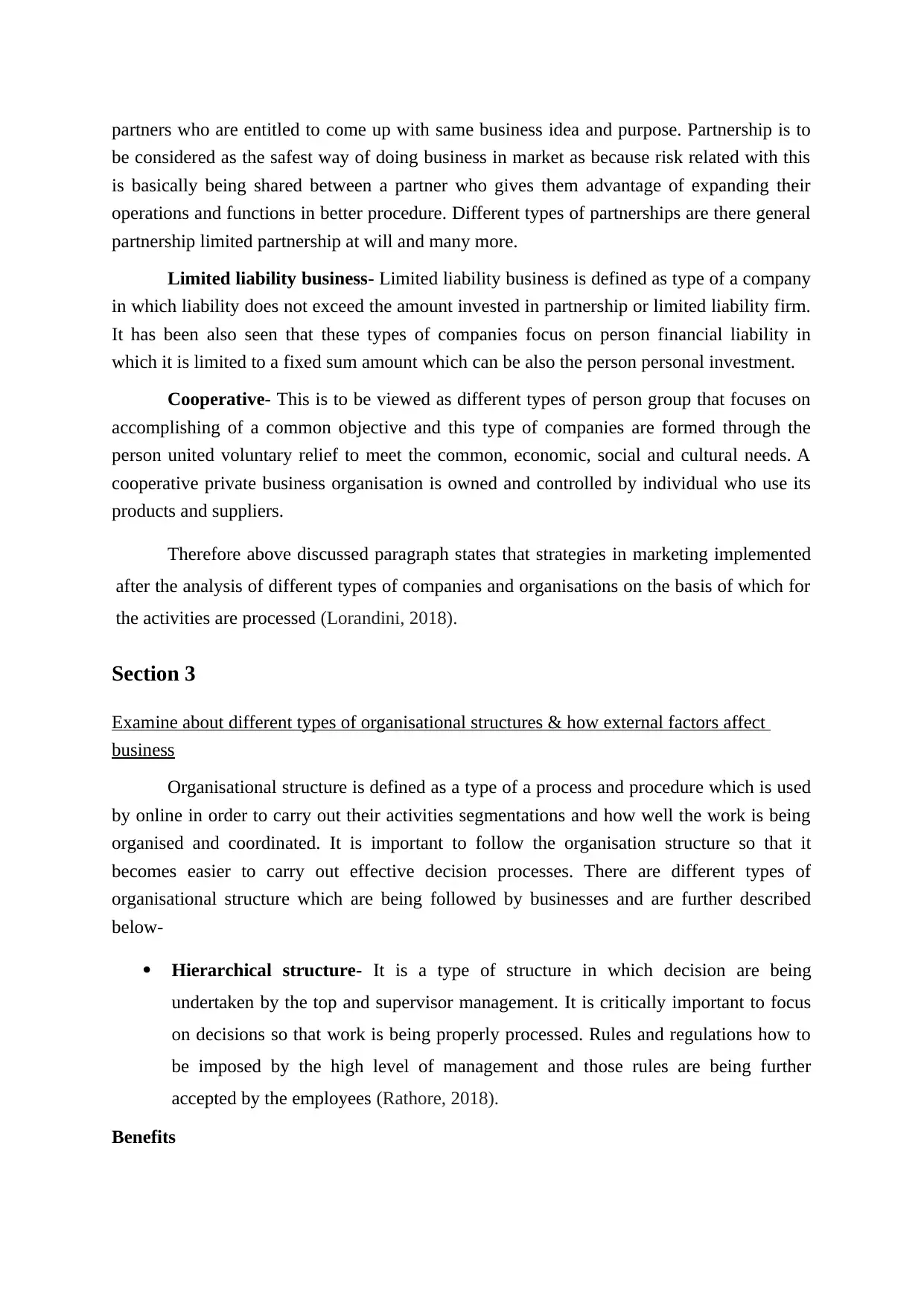
partners who are entitled to come up with same business idea and purpose. Partnership is to
be considered as the safest way of doing business in market as because risk related with this
is basically being shared between a partner who gives them advantage of expanding their
operations and functions in better procedure. Different types of partnerships are there general
partnership limited partnership at will and many more.
Limited liability business- Limited liability business is defined as type of a company
in which liability does not exceed the amount invested in partnership or limited liability firm.
It has been also seen that these types of companies focus on person financial liability in
which it is limited to a fixed sum amount which can be also the person personal investment.
Cooperative- This is to be viewed as different types of person group that focuses on
accomplishing of a common objective and this type of companies are formed through the
person united voluntary relief to meet the common, economic, social and cultural needs. A
cooperative private business organisation is owned and controlled by individual who use its
products and suppliers.
Therefore above discussed paragraph states that strategies in marketing implemented
after the analysis of different types of companies and organisations on the basis of which for
the activities are processed (Lorandini, 2018).
Section 3
Examine about different types of organisational structures & how external factors affect
business
Organisational structure is defined as a type of a process and procedure which is used
by online in order to carry out their activities segmentations and how well the work is being
organised and coordinated. It is important to follow the organisation structure so that it
becomes easier to carry out effective decision processes. There are different types of
organisational structure which are being followed by businesses and are further described
below-
Hierarchical structure- It is a type of structure in which decision are being
undertaken by the top and supervisor management. It is critically important to focus
on decisions so that work is being properly processed. Rules and regulations how to
be imposed by the high level of management and those rules are being further
accepted by the employees (Rathore, 2018).
Benefits
be considered as the safest way of doing business in market as because risk related with this
is basically being shared between a partner who gives them advantage of expanding their
operations and functions in better procedure. Different types of partnerships are there general
partnership limited partnership at will and many more.
Limited liability business- Limited liability business is defined as type of a company
in which liability does not exceed the amount invested in partnership or limited liability firm.
It has been also seen that these types of companies focus on person financial liability in
which it is limited to a fixed sum amount which can be also the person personal investment.
Cooperative- This is to be viewed as different types of person group that focuses on
accomplishing of a common objective and this type of companies are formed through the
person united voluntary relief to meet the common, economic, social and cultural needs. A
cooperative private business organisation is owned and controlled by individual who use its
products and suppliers.
Therefore above discussed paragraph states that strategies in marketing implemented
after the analysis of different types of companies and organisations on the basis of which for
the activities are processed (Lorandini, 2018).
Section 3
Examine about different types of organisational structures & how external factors affect
business
Organisational structure is defined as a type of a process and procedure which is used
by online in order to carry out their activities segmentations and how well the work is being
organised and coordinated. It is important to follow the organisation structure so that it
becomes easier to carry out effective decision processes. There are different types of
organisational structure which are being followed by businesses and are further described
below-
Hierarchical structure- It is a type of structure in which decision are being
undertaken by the top and supervisor management. It is critically important to focus
on decisions so that work is being properly processed. Rules and regulations how to
be imposed by the high level of management and those rules are being further
accepted by the employees (Rathore, 2018).
Benefits
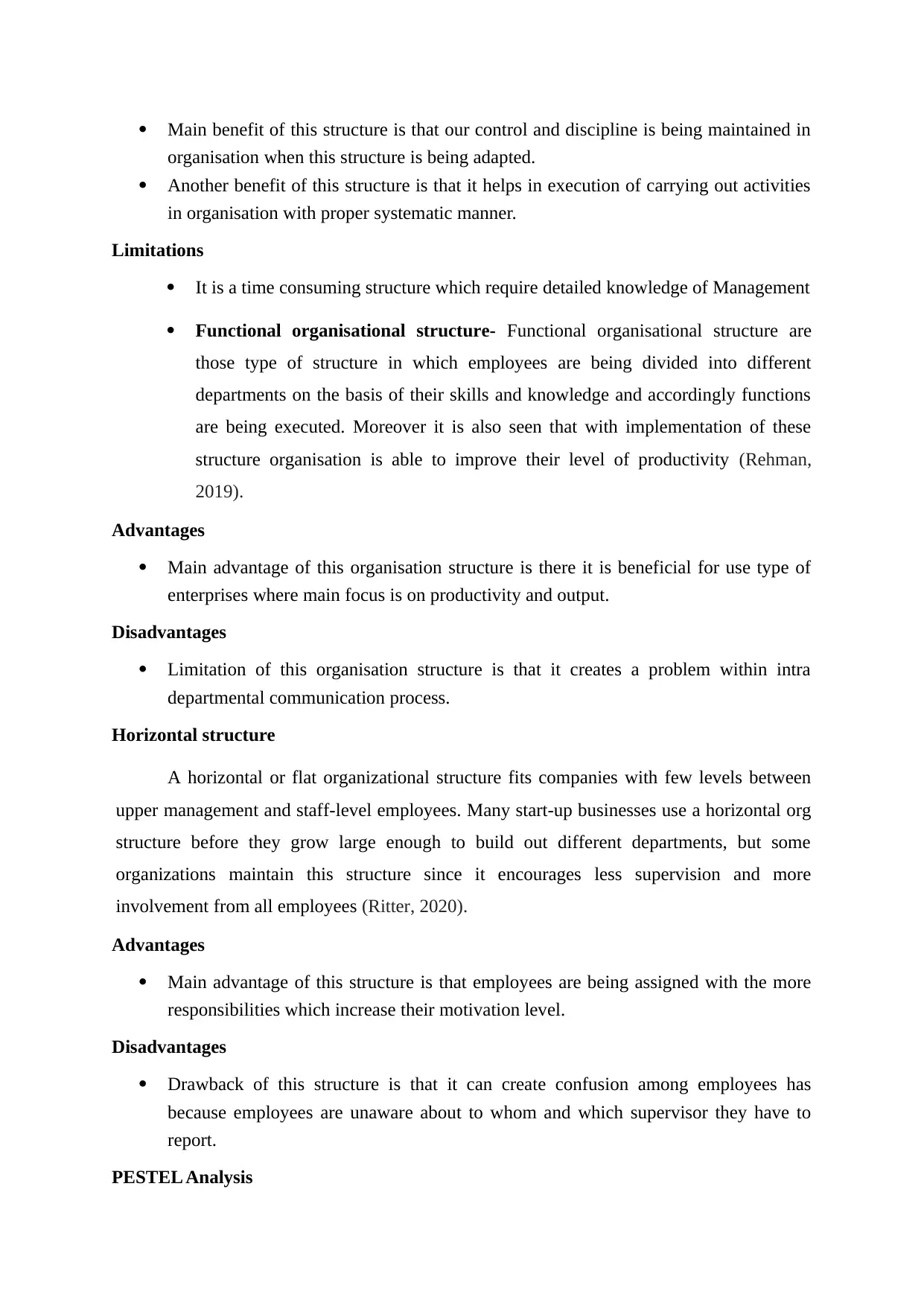
Main benefit of this structure is that our control and discipline is being maintained in
organisation when this structure is being adapted.
Another benefit of this structure is that it helps in execution of carrying out activities
in organisation with proper systematic manner.
Limitations
It is a time consuming structure which require detailed knowledge of Management
Functional organisational structure- Functional organisational structure are
those type of structure in which employees are being divided into different
departments on the basis of their skills and knowledge and accordingly functions
are being executed. Moreover it is also seen that with implementation of these
structure organisation is able to improve their level of productivity (Rehman,
2019).
Advantages
Main advantage of this organisation structure is there it is beneficial for use type of
enterprises where main focus is on productivity and output.
Disadvantages
Limitation of this organisation structure is that it creates a problem within intra
departmental communication process.
Horizontal structure
A horizontal or flat organizational structure fits companies with few levels between
upper management and staff-level employees. Many start-up businesses use a horizontal org
structure before they grow large enough to build out different departments, but some
organizations maintain this structure since it encourages less supervision and more
involvement from all employees (Ritter, 2020).
Advantages
Main advantage of this structure is that employees are being assigned with the more
responsibilities which increase their motivation level.
Disadvantages
Drawback of this structure is that it can create confusion among employees has
because employees are unaware about to whom and which supervisor they have to
report.
PESTEL Analysis
organisation when this structure is being adapted.
Another benefit of this structure is that it helps in execution of carrying out activities
in organisation with proper systematic manner.
Limitations
It is a time consuming structure which require detailed knowledge of Management
Functional organisational structure- Functional organisational structure are
those type of structure in which employees are being divided into different
departments on the basis of their skills and knowledge and accordingly functions
are being executed. Moreover it is also seen that with implementation of these
structure organisation is able to improve their level of productivity (Rehman,
2019).
Advantages
Main advantage of this organisation structure is there it is beneficial for use type of
enterprises where main focus is on productivity and output.
Disadvantages
Limitation of this organisation structure is that it creates a problem within intra
departmental communication process.
Horizontal structure
A horizontal or flat organizational structure fits companies with few levels between
upper management and staff-level employees. Many start-up businesses use a horizontal org
structure before they grow large enough to build out different departments, but some
organizations maintain this structure since it encourages less supervision and more
involvement from all employees (Ritter, 2020).
Advantages
Main advantage of this structure is that employees are being assigned with the more
responsibilities which increase their motivation level.
Disadvantages
Drawback of this structure is that it can create confusion among employees has
because employees are unaware about to whom and which supervisor they have to
report.
PESTEL Analysis
⊘ This is a preview!⊘
Do you want full access?
Subscribe today to unlock all pages.

Trusted by 1+ million students worldwide
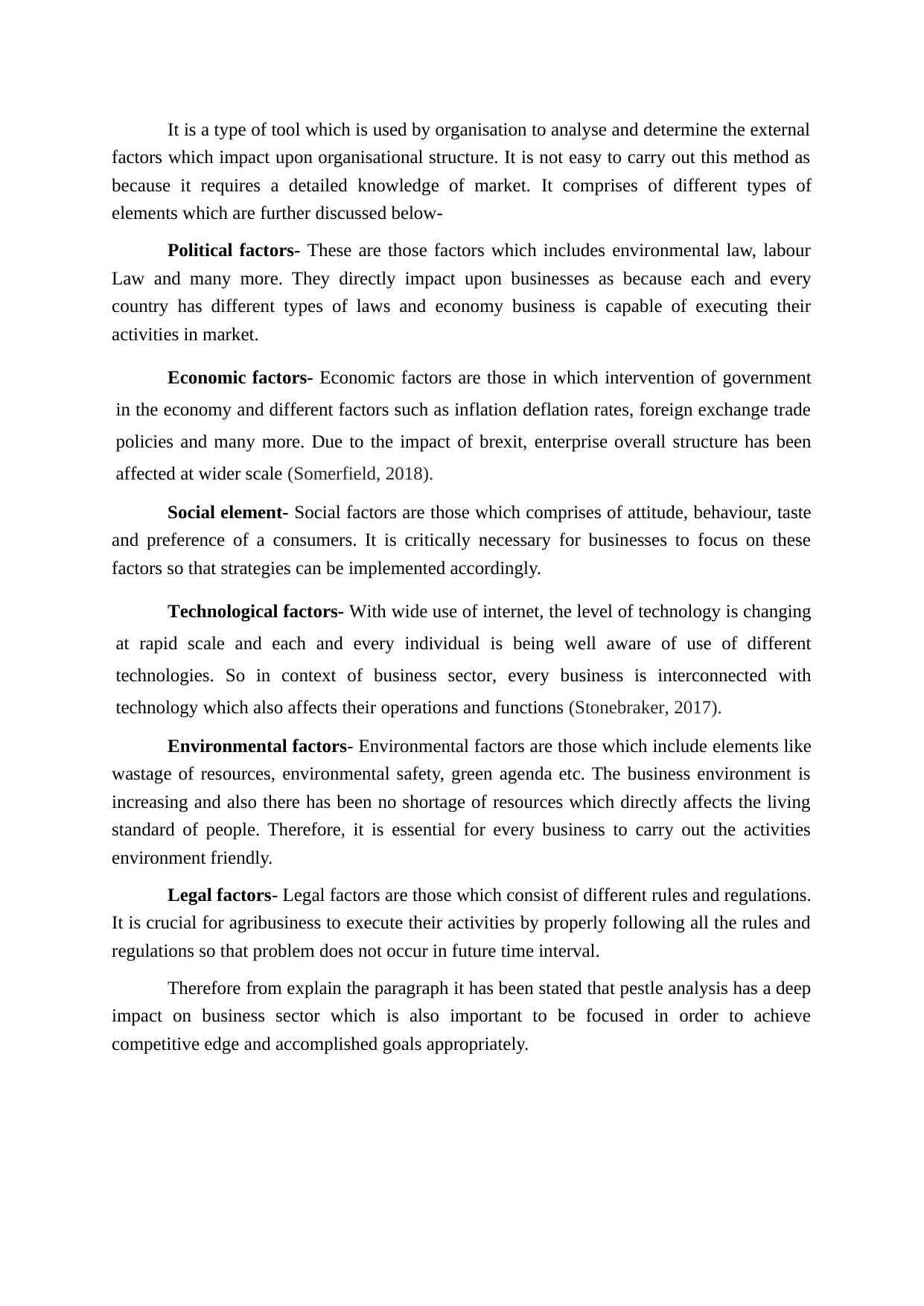
It is a type of tool which is used by organisation to analyse and determine the external
factors which impact upon organisational structure. It is not easy to carry out this method as
because it requires a detailed knowledge of market. It comprises of different types of
elements which are further discussed below-
Political factors- These are those factors which includes environmental law, labour
Law and many more. They directly impact upon businesses as because each and every
country has different types of laws and economy business is capable of executing their
activities in market.
Economic factors- Economic factors are those in which intervention of government
in the economy and different factors such as inflation deflation rates, foreign exchange trade
policies and many more. Due to the impact of brexit, enterprise overall structure has been
affected at wider scale (Somerfield, 2018).
Social element- Social factors are those which comprises of attitude, behaviour, taste
and preference of a consumers. It is critically necessary for businesses to focus on these
factors so that strategies can be implemented accordingly.
Technological factors- With wide use of internet, the level of technology is changing
at rapid scale and each and every individual is being well aware of use of different
technologies. So in context of business sector, every business is interconnected with
technology which also affects their operations and functions (Stonebraker, 2017).
Environmental factors- Environmental factors are those which include elements like
wastage of resources, environmental safety, green agenda etc. The business environment is
increasing and also there has been no shortage of resources which directly affects the living
standard of people. Therefore, it is essential for every business to carry out the activities
environment friendly.
Legal factors- Legal factors are those which consist of different rules and regulations.
It is crucial for agribusiness to execute their activities by properly following all the rules and
regulations so that problem does not occur in future time interval.
Therefore from explain the paragraph it has been stated that pestle analysis has a deep
impact on business sector which is also important to be focused in order to achieve
competitive edge and accomplished goals appropriately.
factors which impact upon organisational structure. It is not easy to carry out this method as
because it requires a detailed knowledge of market. It comprises of different types of
elements which are further discussed below-
Political factors- These are those factors which includes environmental law, labour
Law and many more. They directly impact upon businesses as because each and every
country has different types of laws and economy business is capable of executing their
activities in market.
Economic factors- Economic factors are those in which intervention of government
in the economy and different factors such as inflation deflation rates, foreign exchange trade
policies and many more. Due to the impact of brexit, enterprise overall structure has been
affected at wider scale (Somerfield, 2018).
Social element- Social factors are those which comprises of attitude, behaviour, taste
and preference of a consumers. It is critically necessary for businesses to focus on these
factors so that strategies can be implemented accordingly.
Technological factors- With wide use of internet, the level of technology is changing
at rapid scale and each and every individual is being well aware of use of different
technologies. So in context of business sector, every business is interconnected with
technology which also affects their operations and functions (Stonebraker, 2017).
Environmental factors- Environmental factors are those which include elements like
wastage of resources, environmental safety, green agenda etc. The business environment is
increasing and also there has been no shortage of resources which directly affects the living
standard of people. Therefore, it is essential for every business to carry out the activities
environment friendly.
Legal factors- Legal factors are those which consist of different rules and regulations.
It is crucial for agribusiness to execute their activities by properly following all the rules and
regulations so that problem does not occur in future time interval.
Therefore from explain the paragraph it has been stated that pestle analysis has a deep
impact on business sector which is also important to be focused in order to achieve
competitive edge and accomplished goals appropriately.
Paraphrase This Document
Need a fresh take? Get an instant paraphrase of this document with our AI Paraphraser

CONCLUSION
After brief analysis of above discussed report, it has been specified that it is essential
to focus on market size and various kinds of organisations so that it is easier to make
decisions. So, discussions have been made about different types of companies, various kinds
of enterprises from sole traders to partnerships and different business structures and impact of
external factors has been explained briefly. It has been evaluated that a proper analysis is
required to be made by the businesses so that goals and objectives are accomplished within
time period without facing any problem.
After brief analysis of above discussed report, it has been specified that it is essential
to focus on market size and various kinds of organisations so that it is easier to make
decisions. So, discussions have been made about different types of companies, various kinds
of enterprises from sole traders to partnerships and different business structures and impact of
external factors has been explained briefly. It has been evaluated that a proper analysis is
required to be made by the businesses so that goals and objectives are accomplished within
time period without facing any problem.
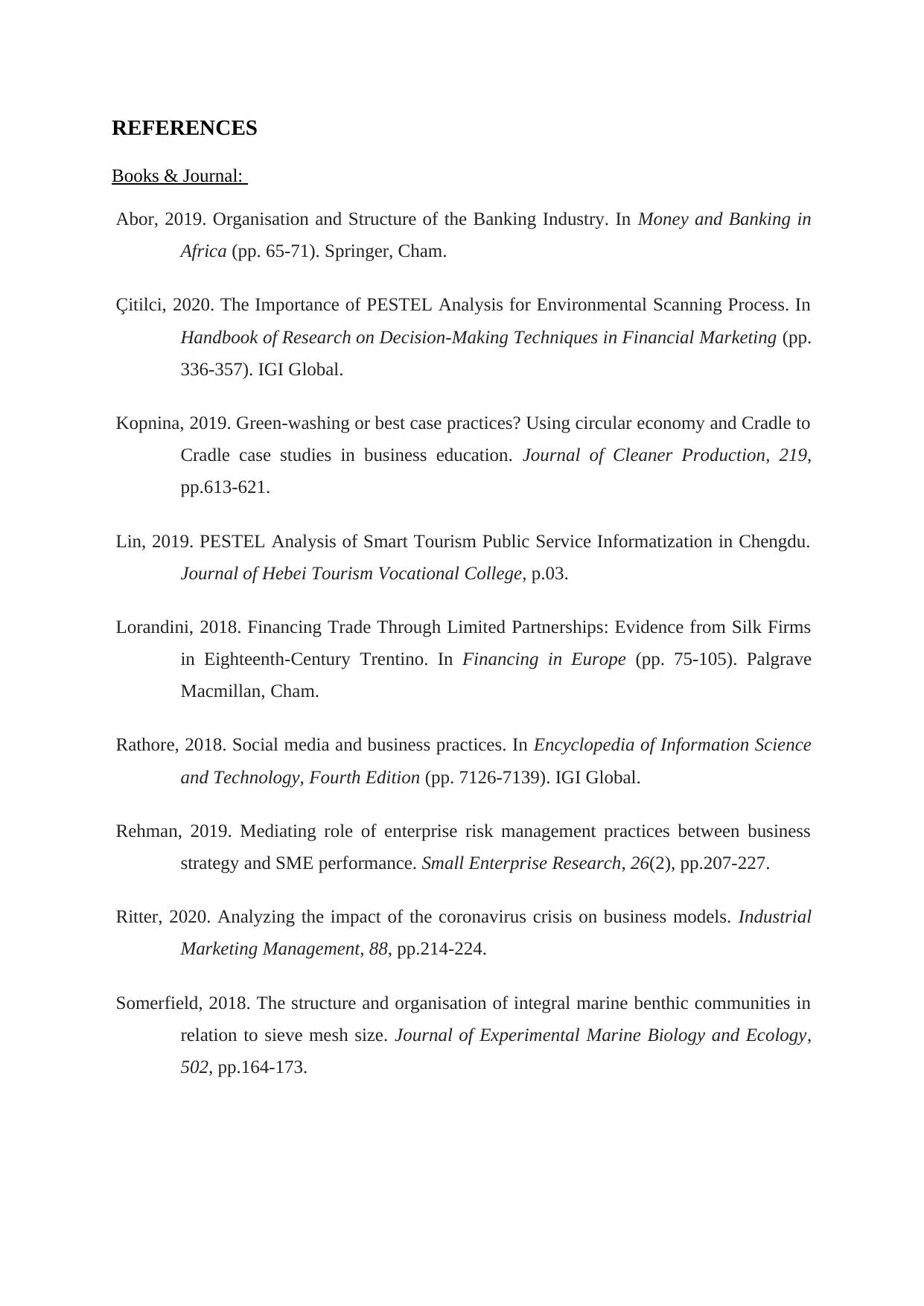
REFERENCES
Books & Journal:
Abor, 2019. Organisation and Structure of the Banking Industry. In Money and Banking in
Africa (pp. 65-71). Springer, Cham.
Çitilci, 2020. The Importance of PESTEL Analysis for Environmental Scanning Process. In
Handbook of Research on Decision-Making Techniques in Financial Marketing (pp.
336-357). IGI Global.
Kopnina, 2019. Green-washing or best case practices? Using circular economy and Cradle to
Cradle case studies in business education. Journal of Cleaner Production, 219,
pp.613-621.
Lin, 2019. PESTEL Analysis of Smart Tourism Public Service Informatization in Chengdu.
Journal of Hebei Tourism Vocational College, p.03.
Lorandini, 2018. Financing Trade Through Limited Partnerships: Evidence from Silk Firms
in Eighteenth-Century Trentino. In Financing in Europe (pp. 75-105). Palgrave
Macmillan, Cham.
Rathore, 2018. Social media and business practices. In Encyclopedia of Information Science
and Technology, Fourth Edition (pp. 7126-7139). IGI Global.
Rehman, 2019. Mediating role of enterprise risk management practices between business
strategy and SME performance. Small Enterprise Research, 26(2), pp.207-227.
Ritter, 2020. Analyzing the impact of the coronavirus crisis on business models. Industrial
Marketing Management, 88, pp.214-224.
Somerfield, 2018. The structure and organisation of integral marine benthic communities in
relation to sieve mesh size. Journal of Experimental Marine Biology and Ecology,
502, pp.164-173.
Books & Journal:
Abor, 2019. Organisation and Structure of the Banking Industry. In Money and Banking in
Africa (pp. 65-71). Springer, Cham.
Çitilci, 2020. The Importance of PESTEL Analysis for Environmental Scanning Process. In
Handbook of Research on Decision-Making Techniques in Financial Marketing (pp.
336-357). IGI Global.
Kopnina, 2019. Green-washing or best case practices? Using circular economy and Cradle to
Cradle case studies in business education. Journal of Cleaner Production, 219,
pp.613-621.
Lin, 2019. PESTEL Analysis of Smart Tourism Public Service Informatization in Chengdu.
Journal of Hebei Tourism Vocational College, p.03.
Lorandini, 2018. Financing Trade Through Limited Partnerships: Evidence from Silk Firms
in Eighteenth-Century Trentino. In Financing in Europe (pp. 75-105). Palgrave
Macmillan, Cham.
Rathore, 2018. Social media and business practices. In Encyclopedia of Information Science
and Technology, Fourth Edition (pp. 7126-7139). IGI Global.
Rehman, 2019. Mediating role of enterprise risk management practices between business
strategy and SME performance. Small Enterprise Research, 26(2), pp.207-227.
Ritter, 2020. Analyzing the impact of the coronavirus crisis on business models. Industrial
Marketing Management, 88, pp.214-224.
Somerfield, 2018. The structure and organisation of integral marine benthic communities in
relation to sieve mesh size. Journal of Experimental Marine Biology and Ecology,
502, pp.164-173.
⊘ This is a preview!⊘
Do you want full access?
Subscribe today to unlock all pages.

Trusted by 1+ million students worldwide

Stonebraker, 2017. Realizing critical business information literacy: Opportunities,
definitions, and best practices. Journal of Business & Finance Librarianship, 22(2),
pp.135-148.
Sundqvist, 2020. Meal identity as practice-Towards an understanding of business travellers’
meal practices. International Journal of Gastronomy and Food Science, 22,
p.100237.
definitions, and best practices. Journal of Business & Finance Librarianship, 22(2),
pp.135-148.
Sundqvist, 2020. Meal identity as practice-Towards an understanding of business travellers’
meal practices. International Journal of Gastronomy and Food Science, 22,
p.100237.
1 out of 10
Related Documents
Your All-in-One AI-Powered Toolkit for Academic Success.
+13062052269
info@desklib.com
Available 24*7 on WhatsApp / Email
![[object Object]](/_next/static/media/star-bottom.7253800d.svg)
Unlock your academic potential
Copyright © 2020–2025 A2Z Services. All Rights Reserved. Developed and managed by ZUCOL.





